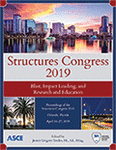Structures Congress 2019
Effects of Shear Studs in Composite Columns’ P-M Interaction Diagrams
Publication: Structures Congress 2019: Blast, Impact Loading, and Research and Education
ABSTRACT
Composite construction including composite columns are widely used in structural design. In the transmission towers’ industry, composite columns are replacing the old timber and steel adopted designs. Research on the capacity and behavior of these traditional columns has been previously performed, yet few researchers investigated the behavior of hybrid composite columns, such as concrete filled steel tube (CFST) with embedded steel section or embedded steel tube (double skin column) and studs. Besides the non-homogeneity in concrete composition, choosing the right geometry for embedded steel components and their distribution pattern in the column section presents a challenge in achieving maximum section capacity. This study focuses on developing the P-M Interaction diagrams for different geometrical column shapes highly used in the industry such as hexagonal, octagonal, decagonal shapes, and the effect of adding headed shear studs on such diagrams. Three-dimensional non-linear finite element models were built using ABAQUS to compare and validate the behavior of the transmission towers against experimental work. The models include detailed analysis and investigation of the concrete and steel components behavior up to failure using concrete damage plasticity (CDP) and bilinear elasto-plastic model respectively. Good comparison between the FE results of such sections and previously studied columns has been achieved which leads to studying and investigating multiple forms of composite transmission towers. P-M Interaction diagrams were constructed for the proposed shapes for various diameter-to-steel thickness ratio (D/t) beyond AISC code limitations. Further extensive study was performed to investigate the effect of number of studs, studs’ dimensions, and studs’ arrangement in the cross-section and along the column length on the capacity of the columns. It was concluded from this study that certain arrangement and a smaller number of studs can give the desired capacity which is more economical and requires less efforts.
Get full access to this article
View all available purchase options and get full access to this chapter.
REFERENCES
ABAQUS (2014). Analysis user’s manual 6.14-EF, Dassault Systems Simulia Corp., Providence, RI.
American Concrete Institute (ACI) (1999). “Building code requirements for structural concrete and commentary.” ACI 318-99, Detroit.
AISC (2010). Steel Construction Manual,14thed., American Institute of Steel Construction, Chicago, Illinois.
Chovichien, V. (2004). “The behavior and design of piles for integral abutment bridges.” Purdue University, PhD dissertation.
Fouad, F., Foust, F., Oliphant, W.J. (2006). “A Composite Steel-Concrete Monopole for Electrical Transmission Lines.” Electrical Transmission Line and Substation Structures, 382-390.
Hajjar, J.F., Schiller, P.H., A. A. Molodan, (1998). “Distributed plasticity model for concrete filled steel tube beam columns with interlayer slip.” Engineering Structures, 20 (8), pp. 663-676.
Han, L. H., Huo, JS. (2003). “Concrete-filled HSS columns after exposure to ISO-834 standard fire.” Journal of Structural Engineering., 129(1), 68–78.
Han, L. H., Huo, JS. (2004). “Flexural behavior of concrete-filled steel tubes.” Journal of Constructional Steel Research, 60, 313–337
Hsuan-The, Hu., Chiung-Shiann, H., Ming-Hsien, Wu., Yih-Min, Wu., (2003). “Nonlinear Analysis of Axially Loaded Concrete-Filled Tube Columns with Confinement Effect.” Journal of Structural Engineering, 129(10).
H. Hu C. Huang M.H. Wu Y.M. Wu (2003). “Nonlinear Analysis of Axially Loaded Concrete Filled Tube Columns with Confinement Effect.” Journal of Structural Engineering, 129(10).
Huang, C. S. (2002). “Axial load behavior of stiffened concrete- filled steel columns.” Journal of Structural Engineering,128 9 1222–1230.
Saenz, L. P. (1964). “Discussion of ‘Equation for the stress-strain curve of concrete.” ACI Journal, 61, 1229–1235.
Schneider, S. P. (1998). “Axially loaded concrete-filled steel tubes.” Journal of Structural Engineering, 124 10, 1125–1138.
Tao, Z., Song, T., Uy, B., Han, L. (2016). “Bond behavior in concrete-filled steel tubes.” Journal of Constructional Steel Research, 120, 81-93.
Thivya, J., Malathy, R., Tensing, D. (2016). “Experimental investigation of confined steel concrete composite beam under bending.” International Journal of advanced Engineering Technology, VII/Issue I/Jan-March 716-720.
Xu, C., Sugiura, K., (2013). “FEM Analysis in failure development of group studs shear connector under effects of concrete strength and stud dimension.” Engineering Failure Analysis, 35, 343-354.
Information & Authors
Information
Published In
Structures Congress 2019: Blast, Impact Loading, and Research and Education
Pages: 301 - 313
Editor: James Gregory Soules, McDermott International
ISBN (Online): 978-0-7844-8224-7
Copyright
© 2019 American Society of Civil Engineers.
History
Published online: Apr 22, 2019
Authors
Metrics & Citations
Metrics
Citations
Download citation
If you have the appropriate software installed, you can download article citation data to the citation manager of your choice. Simply select your manager software from the list below and click Download.
